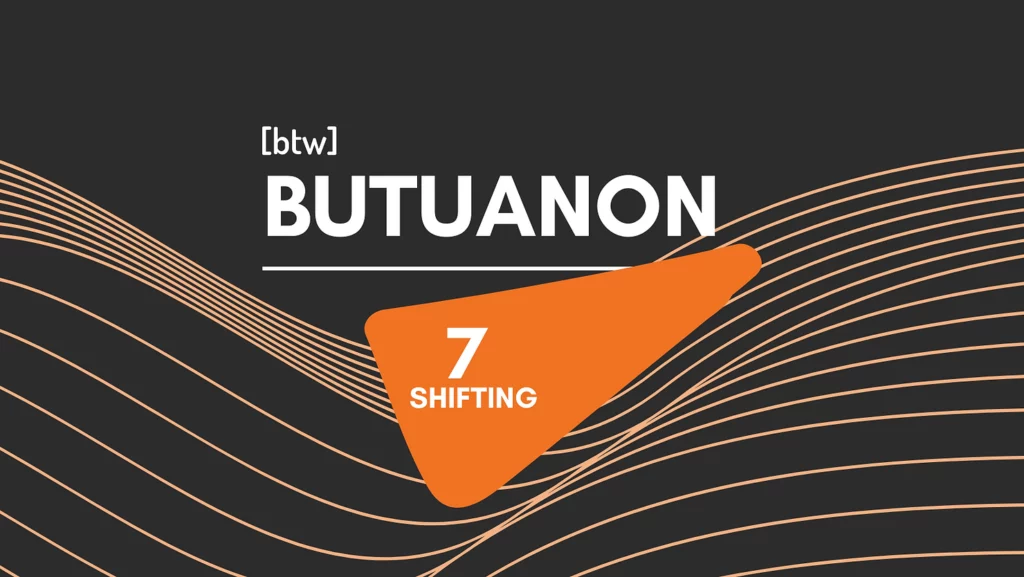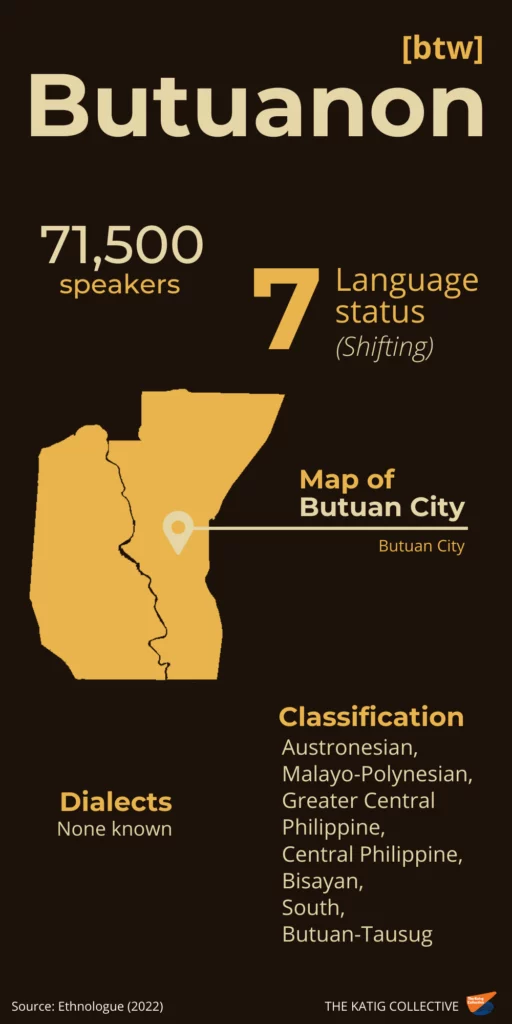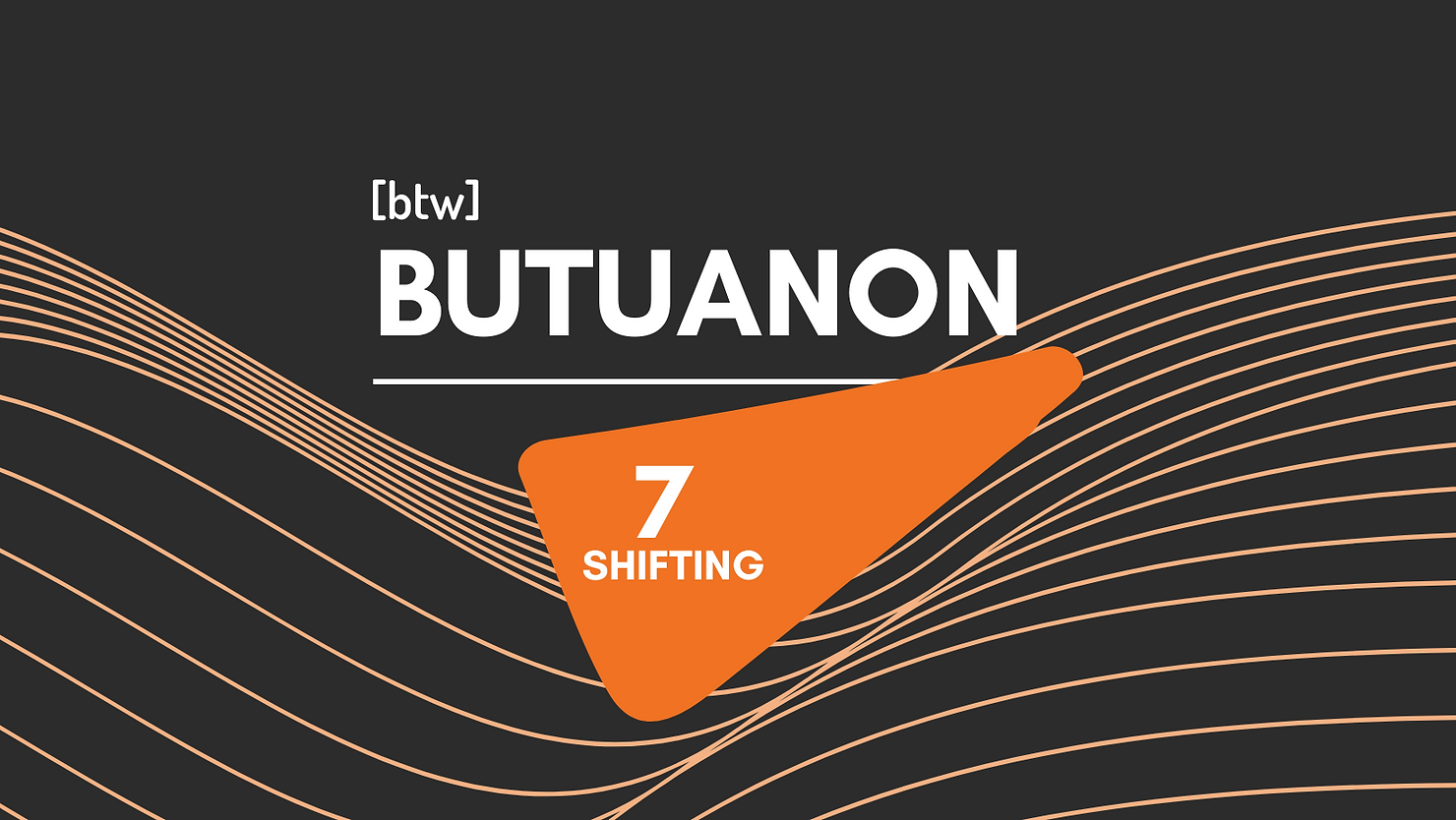Butuanon
Butuanon [btw] is spoken in Butuan City, Agusan del Norte and in some parts of Agusan del Sur, Misamis Oriental, and Surigao del Norte (Eberhard et al., 2022; Molina, 2021). It is closely related to the Tausug language [tsg] of Jolo and also has a very close affinity to the Kamayo language [kyk] of Bislig (Molina, 2021; NCCA, 2021). The United Nations Statistics Division (UNSD) reported in 2005 that there were 71,500 speakers of Butuanon (as cited in Eberhard et al., 2022), but as of 2007, less than 500 younger speakers use the language in Butuan (Cabuang, 2007, as cited in Molina, 2021).

Language and society
Ethnologue classified Butuanon as shifting (EGIDS 7), meaning it is spoken only by the parent generation and is no longer transmitted to their children (Eberhard et al., 2022). Butuanon is also not used in schools since lessons are delivered in Cebuano [ceb], English [eng], and Filipino [fil] (Molina, 2021). Natives thus find themselves in an environment heavily influenced by Bisayanization and where they are discriminated against by the dominant Cebuano group. They experience the pressure of assimilating into the Cebuano culture and using a different language (Kobari, 2016; Molina, 2021).
In 2005, the non-profit organization Save Our Languages through Federalism (SOLFED)–Butuan chapter attempted to salvage Butuanon by spearheading a project of creating Butuanon syllabi and grammar books. They received the support of The Butuan Charities of Southern California and Butuan Ivory Charities to fund the teaching of Butuanon in public schools. It was taught in selected SPED schools in 2006. Despite the positive feedback it received, the project was eventually halted due to a lack of funding and support from the government (Cabuang, 2007). More than 15 years later, Butuanon is among the indigenous languages that received recognition through the 2021 Bantayog–Wika project of the Komisyon sa Wikang Filipino (KWF). This aims to erect a monument that promotes the use of native tongues and raises awareness of their vitality status (Teves, 2021).

Work about Butuanon
Still, only a few studies have been conducted on the Butuanon language to date. Kobari (2009; 2016) published works about the status of Butuanon and its speakers, while Molina (2021) wrote a description of Butuanon grammar. Glottolog also listed several works that mention or feature the Butuanon language.
References
Beltran, M. V. (2014, February 10). Pigadagit (Taken/ a Butuanon film) [Video]. YouTube. https://www.youtube.com/watch?v=xRioa6gjTp4
C.E. Smith Anthropology Museum. (2021). Butuanon. CAL State East Bay. https://www.csueastbay.edu/museum/virtual-museum/the-philippines/peoples/butuanon.html
Cabuang, F. S. (2007). This dying Philippine language needs to be saved. Ogmios, 3.08(33), 6-7. Retrieved December 23, 2021, from https://www.ogmios.org/ogmios/Ogmios_033.pdf
Eberhard, D. M., Simons, G. F., & Fennig, C. D. (2022). Butuanon. Ethnologue: Languages of the world (25th ed.). https://www.ethnologue.com/language/btw
Hammarström, H., Forkel, R., Haspelmath, M., & Bank, S. (Eds.). (2022). Spoken L1 language: Butuanon. Glottolog 4.6. https://glottolog.org/resource/languoid/id/butu1244
Kobari, Y. (2009). The current status of the Butuanon language and its speakers in Northern Mindanao: Findings on ethnic identity, language attitudes, language ability, language use, and language change [Doctoral dissertation, De La Salle University]. Animo Repository. https://animorepository.dlsu.edu.ph/etd_doctoral/288/
Kobari, Y. (2016). The game of naming: A case of the Butuanon language and its speakers in the Philippines. Language and Linguistics in Oceania, 8, 1-21. https://izumi-syuppan.co.jp/LLO_PDF/vol_08/16-01Kobari.pdf
Lopez, A. (2021, June 2). Dante displaces over 1.5K families in Agusan Del Norte, Butuan. Philippine News Agency. https://www.pna.gov.ph/articles/1142351
Molina, M. E. (2021). A brief description of the grammar of Butuanon. Diliman Review, 65(1), 59-101. https://journals.upd.edu.ph/index.php/dilimanreview/article/view/8229
National Commission for Culture and the Arts. (2021). Peoples of the Philippines: Butuanon. https://ncca.gov.ph/about-culture-and-arts/culture-profile/glimpses-peoples-of-the-philippines/butuanon/
Mascariñas, E. (2018, May 13). ‘Balangay’ recalls glory days of Butuan trade. Inquirer.net. https://newsinfo.inquirer.net/989924/balangay-recalls-glory-days-of-butuan-trade
Teves, C. (2021, January 26). KWF to launch 6 language monuments in June. Philippine News Agency. https://www.pna.gov.ph/articles/1128574
Zorc, D. P. (1977). The Bisayan dialects of the Philippines: Subgrouping and reconstruction. Australian National University. http://sealang.net/archives/pl/pdf/PL-C44.pdf

